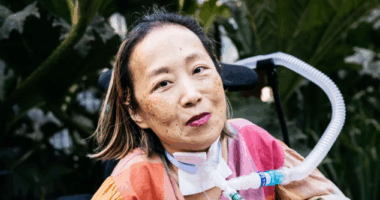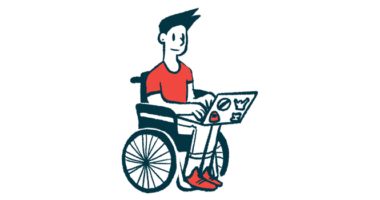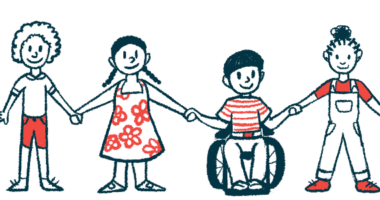
Occupational therapy for SMA
Last updated Nov. 28, 2024, by Susie Strachan, MS

Spinal muscular atrophy (SMA) is a genetic condition that causes muscle weakness and atrophy, which can affect your ability to take care of daily tasks. Occupational therapy (OT) can help with managing the challenges of SMA by maintaining mobility, supporting independence, and improving your overall quality of life.
You may also be shown how to use adaptive equipment, learn exercises for strength, and get recommendations for home modifications to ensure safety and accessibility.
What is occupational therapy?
OT provides strategies to help with daily life. Your occupational therapist will discuss your goals and together develop a plan, such as addressing muscle weakness, mobility issues, and doing everyday tasks.
SMA occupational therapy can help with everything from self-care tasks, such as eating and dressing, to working, going to school, and doing hobbies.
Benefits of occupational therapy for SMA
Occupational therapy for SMA can help you be as independent as possible by enhancing your mobility and ability to participate in activities. Having a dedicated professional to guide you through adaptations and lifestyle changes can make a difference in both your physical and mental health.
Your occupational therapist may become part of your SMA support system as they help you:
- do tasks like eating, dressing, grooming, and bathing by adapting techniques or using specialized equipment such as adaptive utensils or bathroom aids like shower chairs, grab bars, and raised toilet seats
- use mobility aids, such as walkers or wheelchairs, to increase independent movement
- learn exercises or strategies to strengthen your arm, hand, and finger movements for self-care tasks and other activities that require fine motor skills
- practice energy conservation strategies that allow you to complete tasks and save energy for more demanding activities
- make home, school, or work more accessible, such as by changing the placement of furniture or installing ramps or chairlifts
- use technology like computer software or adaptive tools that can help with communication, mobility, and task management
- suggest adaptations to help you do hobbies and leisure activities.
An occupational therapist may also give you strategies to prevent secondary complications, such as contractures, which are the hardening of muscles, tendons or other soft tissues, or pressure sores, which are common in SMA.
Children and adolescents with SMA can also benefit from OT, as it can help them build life skills. By working with your child and adapting the activities to their needs, the occupational therapist can assist with school-related tasks and participation in recreational activities.
Is occupational therapy the same as physiotherapy?
Occupational therapy and physiotherapy (PT), also known as physical therapy, focus on different aspects of SMA rehabilitation. Both have the shared goal of improving your physical abilities, but the two specialties approach it differently.
OT and PT are often used in combination, as mobility, strength, and independence are all interconnected when living with SMA. OT focuses on how you do daily activities and tasks, while the priority in PT is improving or maintaining your strength and mobility.
In OT, your therapist might make suggestions about specialized tools for making adaptations to your home, school, or work environment. In PT, your therapist might suggest exercises to strengthen weak muscles, improve balance, or increase flexibility.
For example, an occupational therapist can assist you with strengthening hand movements to improve your ability to hold utensils, while a physiotherapist can work on the overall mobility and coordination of those muscles.
Being assessed
During an assessment, the occupational therapist tries to get a sense of your daily needs and where you may need additional support. They may ask questions about your mobility, strength, and any difficulties you experience at home, work, or school.
They may also observe how you do certain activities to decide whether you need adaptive equipment, such as special utensils or bathroom aids, or assistive technologies, such as smart home devices.
Treatment strategies
SMA treatment includes medications such as disease-modifying therapies, as well as supportive treatments. In addition to OT and PT, you may need respiratory support, speech therapy, nutritional advice, and mental health support.
An occupational therapist can suggest strategies for managing fatigue and conserving energy, along with breathing exercises to strengthen your respiratory system and exercises to help you maintain muscle strength and flexibility.
An occupational therapist can also work with you on how to use specialized equipment and adaptations that can help with your mobility, while assessing and considering mobility limitations.
These might include:
- walkers to provide balance and arm support
- orthotic splints and braces to support the feet and maintain foot alignment while standing and walking
- standing frames to help you get up from a sitting or lying position
- wheelchairs, either manual or electric, if you’re unable to walk, or if walking is too exhausting
- wheelchair positioning devices to help maintain a straight sitting posture when weakness of the muscles along the spinal column cause scoliosis (curvature of the spine)
- adaptive tricycles for young children with SMA or adults who need help with balance while riding a bike.
Collaborative care
Occupational therapy and SMA care teams can work together to manage SMA symptoms and your overall well-being.
Your SMA care team, which often includes neurologists, physical therapists, speech therapists, and other specialists, addresses the broader aspects of symptom management, such as muscle weakness, respiratory function, and mental health.
Together, they can create a personal care plan that ensures your healthcare needs are met. For example, an OT might recommend adaptive equipment or home modifications, while other members of your care team monitor your overall health and coordinate complementary treatments like physical therapy or nutritional support.
Occupational therapists can also work with parents and caregivers. SMA care training for caregivers can include learning about:
- using adaptive techniques
- using specialized equipment
- potential home modifications to make the living space more comfortable, accessible, and safer.
Occupational therapists can also help caregivers develop skills needed for working and daily living, such as making mental and physical well-being a priority. These include:
- practicing self-care
- spending quality time with loved ones
- reaching out for help.
SMA News Today is strictly a news and information website about the disease. It does not provide medical advice, diagnosis, or treatment. This content is not intended to be a substitute for professional medical advice, diagnosis, or treatment. Always seek the advice of your physician or other qualified health provider with any questions you may have regarding a medical condition. Never disregard professional medical advice or delay in seeking it because of something you have read on this website.
Recent Posts
- SMA community honors legacy of disability rights activist Alice Wong
- Teamwork and faith helped my parents raise children with SMA
- SMA treatment Evrysdi shows multiple benefits for adults
- Upper leg bones are compromised in SMA children who can’t walk: Study
- How I view the intersecting identities of ‘Wicked’




